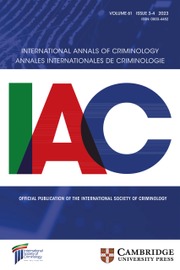Article contents
A Non-Causal Explanation : Containment Theory
Published online by Cambridge University Press: 07 May 2025
Extract
Behavioral scientists, such as psychiatrists, psychologists, and sociologists, have had great difficulty in identifying the operation of various factors or conditions, assumed to be directly related to crime and delinquency. It has been almost impossible to isolate and measure the influence of conditions or factors on behavior of people generally.
Information
- Type
- Lectures - Conférences
- Information
- Copyright
- Copyright © 1963 International Society for Criminology
References
page 220 note (1) This lecture was based upon the text which appeared in «Excerpta Criminologica», 1962.
page 220 note (2) Michael, Jerome and Adler, Mortimer J. : Crime, Law and Social Science. New York, 1933, p. 169.
page 220 note 2. Reckless, Walter C. : Criminal Behavior. New York, p. 255.
page 220 note 3. The first statement of « Containment Theory » is found in the third edition of the author’s textbook on criminology, The crime Problem, New York, 1961, Chapter 18; the second, in an article entitled « Halttheorie », which was published in Monatschrilt für Kriminologie und Strafrechtsreform, Vol. 44, June 1961, pp. 1-14; the third, in Federal Probation, Vol. 25, n° 4, December 1961.
page 220 note (1) It is assumed that people are very infrequently saints and that most conforming people err sometimes; however, they are modally (prevalently) conformists.
- 3
- Cited by

